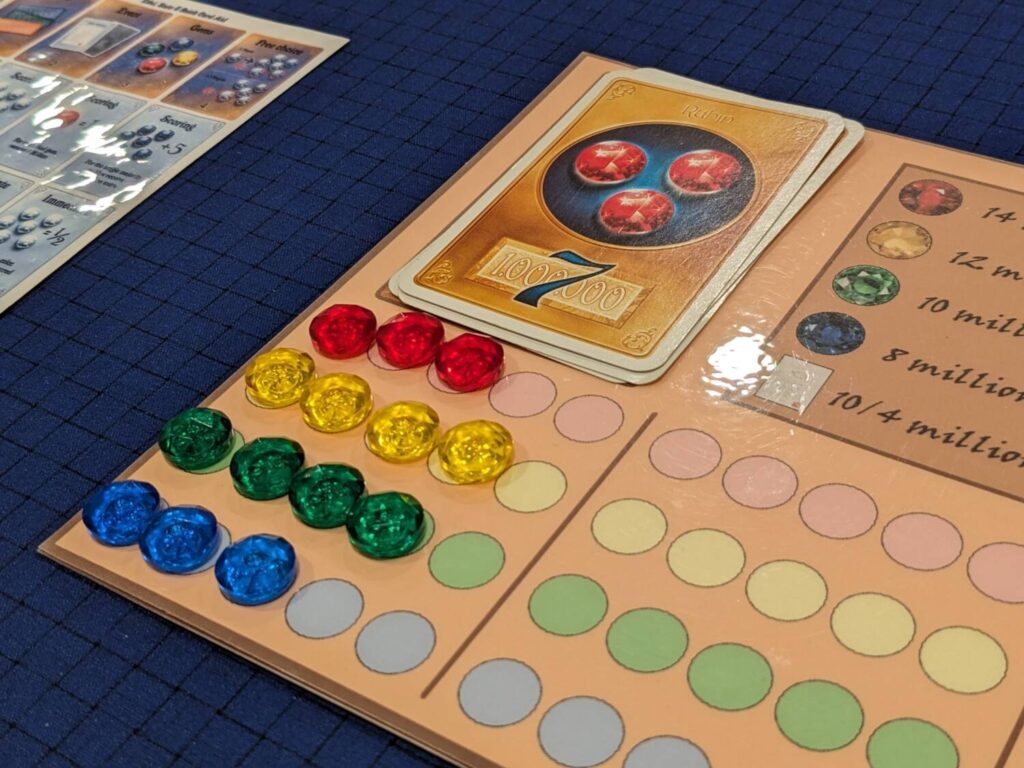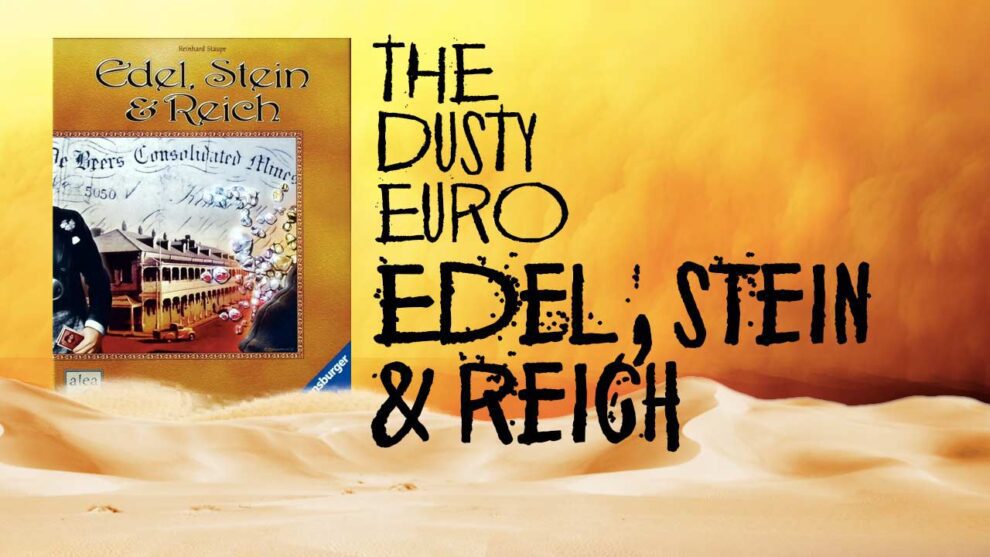The guys in my Wednesday gaming group started a push to play more of the old, dust-ridden games at the bottom and backs of our respective game closet shelves. The premise was simple: let’s try to remember why we keep all these old games when all we ever play now are the newest, shiniest things in shrink.
Right on the spot, the Dusty Euro Series was born, and I’ve enlisted multiple game groups to help me lead the charge on covering older games.
In order to share some of these experiences, I’ll be writing a piece from time to time about a game that is at least 10 years old that we haven’t already reviewed here at Meeple Mountain. In that way, these articles are not reviews. These pieces will not include a detailed rules explanation or a broad introduction to each game. All you get is what you need: my brief thoughts on what I think about each game right now, based on one or two fresh plays.

Edel, Stein & Reich: What Is It?
Edel, Stein & Reich is a 3-5 player negotiation game that plays out over three rounds of a set number of turns comprising each round. Plus, the box has a cover just oozing with images that scream “man, this game is DEFINITELY an old, dusty Euro!” Here’s the description from the publisher, alea/Ravensburger:
“Players take on the roles of directors of the trading house Edel, Stein & Reich, wheeling and dealing at the world’s precious gem exchanges. However, only those who correctly predict their opponent’s intentions will win.
“Players attempt, over three phases, to accumulate as much money as possible. To that end, there are multiple actions that can be carried out: players may choose to increase their gemstone supply, or they may choose Event Cards that may bring additional advantages over the course of the game. Then again, they may choose to simply take whatever amount of cash is currently being offered.
“However, only those players who choose an action that nobody else has chosen get to carry their actions out without hindrance. To that end, it pays to keep an eye on what the other players intend to do…the winner is the player with the most money at the end of the game.”
This is the magic of older Euros…you could basically teach Edel, Stein & Reich from the back of the box. (Why, game designers and publishers, do you keep making games so hard when there are treasures everywhere I look that have rulebooks that are only four or five pages long??)
Every turn, you have to play a card to determine whether you will take the cash offer of the card in front of you, the gems, or a public card known to all players that has a special action or a contract that counts for a majority scoring at the end of each round.
The depth comes from two things—but I can only comment on one of them in detail. The first one, which I don’t know anything about yet, is that Edel, Stein & Reich should only be played with at least four players. A significant amount of, well, something is clearly lost because of how the main tension works: in a three-player game, there are only three options for actions. If everyone picks a different one, each individual player gets what they want (cash, gems, cards).
If two players pick the same thing, they have to negotiate with each other by paying their rival in gems in order to take the action they originally wanted. If three or more players pick the same action, no one gets anything.
But in a four-player game, players still only have three options: cash, gems, cards. At a minimum, you are getting at least one pairing that has to negotiate every single turn. At its worst, all players pick the same action and that leaves everyone on a turn with nothing.
Turns are quick, as players try to play the mind game of figuring out what their neighbors are going to grab next. Cash is king, and when players have a card that has a larger payday (the cards with the $6-$7M totals), there’s always a chance they will take that option. But gems provide a larger payout, only at the end of each round: red gems pay the player who has the majority $14M. If a player has a card in front of them that could grant a couple more red gems, maybe that’s where they will go.
Each turn, there’s a quick decision to make, one that is important but not life threatening, keeping turns moving. Our three-player game of Edel, Stein & Reich took about 40 minutes, and we played two turns too many by mistake in each of our three rounds.

On the One Hand…
Edel, Stein & Reich had the makings of a game I would really enjoy, but ultimately fell flat because of the negotiations that happen when players reveal the same action card.
The player with more red gems (the tiebreaker, since reds are more valuable than the green, yellow, and blue gems) starts a negotiation by offering a gem or two. The next player then has to offer either more in terms of gem value, or more in terms of total gems. Back and forth players will go until someone bites or can’t outbid the previous offer.
I am still struggling to figure out what a good trade looks like. Back in 2003, there apparently wasn’t such a thing as fair trades, so I got hosed a ton of them as I offered a player more gems than a deal really needed. I can’t blame Edel, Stein & Reich for that, but it led to a comically unbalanced score by the end of play as one player essentially lapped the field. I also didn’t love the fact that money was hidden in this game. In essence, players are just hiding their score. But shouldn’t I want to know who’s in the lead, so that I can adapt my strategy to combat what is working for the lead player?
Again, it is clear that Edel, Stein & Reich will play better with four players over three. But I’m not sure the mix of actions will sing even with that fourth player, even though I do like a good negotiation experience. Although it is unlikely, you might go the whole game without getting into a scrap with another player, and taking the money option isn’t that interesting. That means you are hoping that another player takes the same action you do, then trying to fleece them out of enough gems to make the gem majority scoring at the end of a round more appealing.
My one play of Edel, Stein & Reich left me thinking I wouldn’t come back to it, but if we can get four players to the table, I will certainly come back to have a look.










